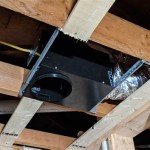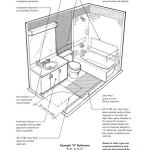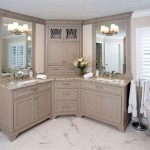Minimum Square Footage for ADA Bathrooms
The Americans with Disabilities Act (ADA) sets forth guidelines for accessible design, including bathroom facilities. These guidelines are in place to ensure that individuals with disabilities can navigate and use bathroom facilities safely and independently. While every bathroom is different, there are minimum square footage requirements for ADA-compliant bathrooms to accommodate essential accessibility features.
The ADA standards address a wide range of accessibility aspects in bathrooms, including the size and configuration of the space, the placement of fixtures and appliances, and the provision of grab bars and other safety features. The minimum square footage requirements are aimed at ensuring that people in wheelchairs or with other mobility limitations have sufficient space to maneuver and use the facilities comfortably and safely.
Understanding Minimum Square Footage Requirements
The ADA Standards for Accessible Design (ADAAG) specify minimum square footage for various types of accessible bathrooms. The minimum square footage requirements vary depending on the type of bathroom, with larger spaces needed for private bathrooms or those intended for more than one person. The following are some key considerations for ADA-compliant bathroom square footage:
Private Bathrooms: Private bathrooms, such as those in residential homes or hotel rooms, have a minimum square footage requirement of 5 feet by 7 feet, resulting in a total area of 35 square feet. This measurement allows ample room for a person in a wheelchair to maneuver freely and use the toilet, sink, and optional shower.
Public Bathrooms: Public restrooms, such as those found in commercial buildings, restaurants, and public spaces, have more stringent square footage requirements. The ADA mandates a minimum of 5 feet by 8 feet, which translates to 40 square feet, for a single-user toilet room. This additional space is necessary to accommodate wheelchair users comfortably and to ensure ample room around the fixtures.
Essential Accessibility Features
In addition to square footage, ADA-compliant bathrooms also require the inclusion of various accessibility features. These features are designed to improve the functionality and safety of the bathroom for people with disabilities. Here are some of the key accessibility features that must be incorporated into ADA-compliant bathrooms:
Grab Bars: Grab bars are crucial for providing stability and support for individuals who may have difficulty maintaining their balance. The ADA standards mandate specific placement and dimensions for grab bars, including placement near the toilet, shower, and bathtub. These grab bars should be installed at a height that allows for easy reach and should be able to withstand a certain amount of weight.
Adequate Clearance: ADA-compliant bathrooms require adequate clearance around fixtures to allow for easy access and maneuverability. This includes clearance around the toilet, sink, and shower. The ADA specifies minimum clearance distances for each fixture, ensuring that individuals using wheelchairs can approach and use them safely and comfortably.
Accessible Shower Stalls: ADA-compliant shower stalls need to be large enough to accommodate a wheelchair and have sufficient height to allow individuals to enter and exit the shower. The shower floor should be level and non-slip to prevent falls. Additionally, the shower controls must be positioned within reach of a seated individual.
Benefits of ADA-Compliant Bathroom Design
Designing bathrooms to comply with ADA standards is not just a matter of legal compliance; it is a matter of creating an inclusive and accessible environment for everyone. Following ADA guidelines ensures that everyone, regardless of their physical abilities, can use and enjoy bathroom facilities with ease and dignity. By adhering to these standards, businesses and individuals can create spaces that are safe, comfortable, and welcoming to all.
In addition to promoting inclusivity, ADA-compliant bathrooms offer other benefits:
- Enhanced Safety: The features and design elements of ADA-compliant bathrooms prioritize safety by minimizing trip hazards, providing stable support surfaces, and ensuring ample clearance for movement.
- Improved Functionality: The thoughtful layout and accessible features of ADA-compliant bathrooms improve their overall functionality by making it easier for individuals to use the facilities independently.
- Increased Accessibility: By creating accessible bathrooms, businesses and individuals can reach a wider audience, including those with disabilities, and enhance their inclusivity. This can lead to greater customer satisfaction and a more diverse and welcoming environment.
Ada Accessible Single User Toilet Room Layout And Requirements Rethink Access Registered Accessibility Specialist Tdlr Ras

What Is The Smallest Commercial Ada Bathroom Layout

Designing Your Ada Compliant Restroom Crossfields Interiors Architecture

Minimum Size Ada Bathroom Google Search Floor Plans Restroom Design

Understanding Ada Design Requirements For Hotels Wheelchair Travel

Ada Bathroom Layout Commercial Restroom Requirements And Plans

Pin On Ada Bathroom
Ada Restroom

Comparison Of Single User Toilet Room Layouts Ada Compliance

7 Important Ada Restroom Requirements For Your Commercial Space
Related Posts







